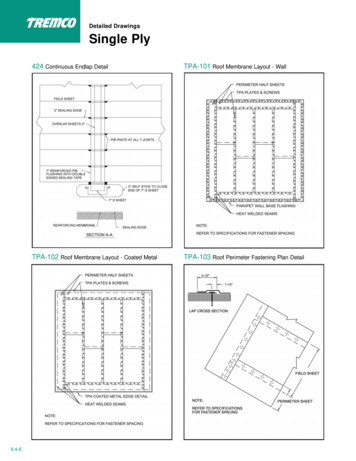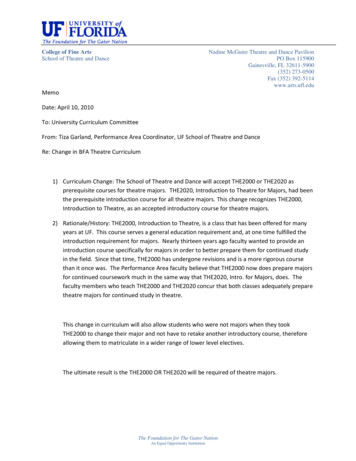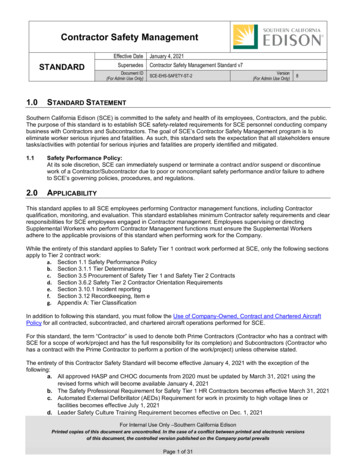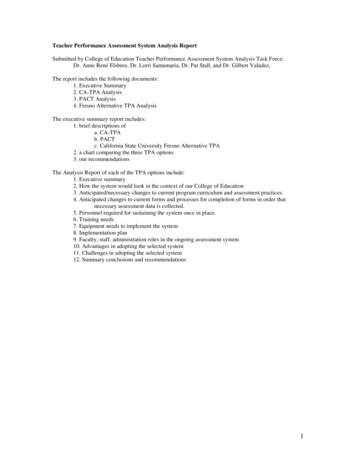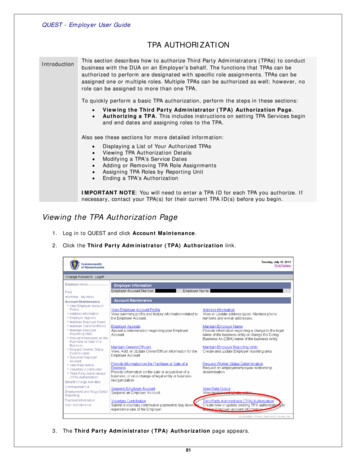
Transcription
TPA Service Pricing andIncentive ContractsHowWen Jeng, A.C.A.S.137
TPA Service Pricing and Incentive ContractsHou-wen Jeng*ABSTRACTThis paper addressesa variety of pricing issues faced by a Third PartyAdministrator(TPA) whosemainresponsibilityis claimshandling for self-insuredemployers and self-insured groups. These issues include the developmentofservice fees using claim closure information, the selection of service durations,and the design of incentive (either activity-based or financially-based) servicecontracts.BIOGRAPHYHou-wen Jeng, ACAS, is an actuary with GatesMcDonald and NationwideInsurance.He holds a B.A. degreein Economicsfrom National Taiwan Universityand an M.A. degreein EconomicsTom the University of Rochester.* I would like to thank Rich Cundy, Rudy Palenik, and Virginia Price for their comments onan earlier draft. All remaining errors are mine.138
1. INTRODUCTIONSelf-insuranceprogramsare designedto capturethe cashflow benefits arisingfrom loss reservesand potential expensesavings. To achieve these goals, selfinsured employersand self-insured groups need to carefully select a professionalservice provider, also known as a Third Party Administrator (TPA). TPAs havesubstantial experiencein claims handling, and they usually have accessto othersupporting services such as actuarial, loss control, managedcare, and retum-towork programs.Thus,a TPA is generallyregardedas the centerpieceof many selfinsured programs.From a servicestandpoint,the mostsignificantdifferencebetweena TPA anda claims departmentof an insurancecompanyis that a TPA provides claims serviceswith a variety of service lengths, ranging from twelve monthsto the life of the claim.The primary productlinesfor self-insuranceare Workers’CompensationandGeneralLiability, which are alsoconsideredlong-tail lines in insurance. Long-tail claims notonly complicate the pricing for TPAs, but greatly affect the TPA fee options andservice lengths available on the market. Given the long-tail nature of the productlines and the variety of the service lengths, TPAs in general have difficulties inforecasting the costsand pricing their products.One might expect that the techniques used in insurance ratemaking andreservingcould shedsomelight on how TPA service pricing should be performed.However, the aggregate approach used in insurance regarding unallocatedadjustmentexpenses(ULAE) is not appropriatefor pricing TPA products. A moredetailedapproachusing service level and closing ratio by claim age seemsto workwell in predicting claim handling costs for various service lengths. Here, we139
emphasize the significance of using claim age in the service fee development.Specifically, service level is assumedto have a functional relationship with claimage, which in turn is related to claims closure distributions. An examplewill beprovided in the paper to illustrate how the information can be combined in thedevelopmentprocess.The last pricing issueto be discussedin the paper is the designof incentivecontracts. This has becomeincreasingly important for TPA pricing, especially inthe area of financial incentive contracts,due to the surging market demand. Twomajor typesof performancemeasurementsfor incentive contractswill be discussedand a recommendationwill be madeafter considering important factors that couldimpact the financial results of a self-insuranceprogram.WhendiscussingTPA pricing proceduresand incentive contracts,the paperwill focus its attention on Workers Compensation. However, the formulas,procedures, and examplescan be easily generalizedto include other lines such asGeneral Liability and Auto Liability.The remainder of the paper is organized as follows. Ln Section 2, we willdiscuss the various service options offered by the TPA industry and theirimplications to TPA revenueaccrual and service planning. Section 3 addressesavariety of pricing issuesfacedby a TPA, including the developmentof service feesusing claims closure information and the selection of service length. Discussionsregardingthe designof incentive(either activity-based or financially-based)servicecontracts and related issuesare contained in Section 4. Concluding remarksarepresentedin Section 5.140
2. FEE OPTIONSAND SERVICELENGTHAs far asthe regulationof pricing is concerned,TPA service pricing is not asclosely examined by state regulatory agenciesas insurancepricing. This is dueperhapsto the samereasoningthat appliesto reinsurancepricing where both partiesare large and knowledgeableregarding the trade in which they are engaged. As aresult, the pricing of TPA service contracts is extremely competitive and TPAsusually needto customizetheir products to fit the needsof their clients.Typically, a TPA is expectedto provide its clients with several service feeoptions,which includePer Claim, Dedicated OfjiceNnit, Percent of Incurred, andPercent of Paid. There may be one or more choices of service length associatedwith eachof the fee options listed above,ranging from twelve monthsto the life ofthe claim. Table 1 lists the major TPA service fee options and the service lengthsavailable for the correspondingfee option. In this section, we will discuss theadvantagesand disadvantagesof thesefee options and their impactson pricing.Table1: Major TPA Service Fee OptionsFee OptionService LengthI2 monthsPer Claim24 monthsl&e of piulnershiplife of claimsame Il.5conlractDedicated OficeNnit% of Incurred/Paid Lossusually lit-e of claim% of Premiumusually lik of claim% of Employeesuunlly life of clnim141
2.1 Per Claim:BasicsSince it is extremely flexible in service length, Per Claim hasbeenthe mostpopular choiceamongself-insureds,where service fees are basedon the numberofclaims receivedby the TPA in the contractperiod. Under Per Claim, a self-insuredclient can choosefrom variousservicelengthsfor the claims to be serviced,such asI2-month, 24-month, Life of Parmership, and Life of Claim. This diversity inservice length is in contrastwith the traditional insurancewhere insurers alwaysservice claims to conclusion.Specifically,the feefor 12-month(24-month) claims service provides claimshandling on new and open claims reported in the contract period for a period oftwelve (twenty four) consecutivemonths. Consider an examplewhere the contractperiod is from l/1/95 to 12/31/95and 24-month is the selectedservice length. Aclaim reported on 3/l/95 will be continuously serviced until 2/28/91, which isfourteen months after the end of the contract period. The total fee calculation isstraightforward as shown in the following:Table2: Per Claim Fee CalculationContract PcrlodService LengthPerClnimChnrgel/l/95for A New Customer- mber of Open Claims200Known 81 or lm9SNumber of New Claims300during Contract PeriodTotal Fee ChargesS250x200 3550x300 Calculated oo 12/3l/!X142%215.000
For a new customer,the chargesfor open claims assumedat the inception ofthe contractcan be easilydeterminedandbilled. New claims (i.e., claimsthat havenever been serviced by any claims administrators) are only billed when they arereportedto the TPA. As a result, the total service chargesunder Per Claim cannotbe determineduntil the endof the contract period. Note that the billing processcanbecome complicated when a customer chooses different service lengths fromcontract to contract.Consider the following Per Claim contracts for a newcustomerstarting in 1995:Table 3: Sample ContractsContract1Contract2III196 - 12All96Contract 3l/1/97-12i3119712 monthsNotice that Contract 1 and Contract 2 have different service lengths. Newclaims reported in 1996 and 1995 will be billed as open claims in 1997 if theyremainopenon their first and secondanniversary dates,respectively. In addition,all the openclaimsassumedat the inceptionof Contract 1 will be billed again if theyare still open on l/1/97. Sincethe service length for Contract 3 is twelve months,they will be available for billing againon l/1/98 if they are not closedby then.To make the Per Claim billing processeven more complicated,a client canchoosedifferent service lengthsfor new and open claims by location and contract.Thus, it is obvious that in order to ensurereceiving proper credits the TPA billingha to be claim-specsc and should be able to keep track of the statusof individualclaims including service length and claim anniversary date. In practice, if the143
current contractis not renewed,it is commonfor TPAs to ceaseservicing all claimsat the end the current contract period regardlessof the service length.Life of Claim servicesprovide claimshandling until seftlemenl at a fixed costfor new and open claims reported to the TPA during the contract period. L@ ofParmership setices are essentially the sameas Life of Claim servicesexcept thatthe TPA will stop servicing all exisfing open claims if the contractual relationshipbetween the TPA and the self-insured regardingfurure claims ceases. Due tocompetitive pressure,some TPAs may sell Life of Partnership service under thedisguise of Life of Claim service with a lower price in hope of gaining customers.Self-insuredsshouldcarefully studythe languageof their service contractsregardingservice length to avoid the consequencesof such market misconduct.2.2 Per Claim:IssuesSelf-insuredscan reduce claims servicing cost by choosing a service lengththat bestfits their self-insuranceprogram. For example,if a self-insuredfinds fromits own experiencethat most of its claims can be closed within two years after theclaims are first reported,a 24-month service plan may be the best choice. A tailclaim servicecanbe purchasedto handleany openclaimsafter two yearsof service.On the otherhand,f?oma TPA’sperspective,the longer the service length, the moreuncertainty in service pricing and revenue accrual. Thus, to avoid adverseselections, a TPA needs to figure out appropriate pricing relativities betweendifferent servicelengths,investigatethe closure patternsof prospectiveclients, andimpose risk chargesfor longer service lengths.Similar to unearnedpremium reservesin insurance, portions of the TPA144
revenue 6om a service contract need to be deferred when the service length runsacross two or more calendar years. Note that the straight-line method used incalculatingunearnedpremiumreservescannot be applied to the calculation of TPAservicefeedeferrals. This is becauseonehasto recognizethe uneven service levelsat the variousdevelopmentagesof a long-tail claim. In other words, the age of theclaim is critical in determiningthe averageamountof time examinersspendon theclaim. As a generalrule, the older the claims, the less time they needfor service.The pricing procedureto be discussedin Section 3 specifically usesthis premiseindetermining service chargesfor Per Claim.Basedon the abovediscussions,it appearsthat for contractswith long servicelength, casualtyactuariescan provide valuable servicesin the areasof TPA pricingand revenuedeferral, as theseare usually unfamiliar territories to TPA executives.Most self-insureds,however, arejust as uncomfortableas TPAs to enter a contractwith a long servicelength. In practice,1Zmonth handlingis the predominantchoiceby self-insuredsfor their TPA servicecontracts.This phenomenoncan be attributedto the following three reasons:-- First, sincemostself-insuredsare consciousof costreduction,the selectionof a shorter duration service plan can further help their cashflow.-- Second,shorterservicedurationsmake it easierfor a self-insuredto moveits program to anotherTPA if it is not satisfied with the current TPA’sservices.--- Third, when the service contract for future claims betweena TPA and aself-insuredis not renewed,it would not be in the interest of the selfinsured to have the same TPA handle their existing open claims due to alack of financial incentives on the part of the TPA. In the caseof Lifeof Claim handling, the self-insured and the TPA needto be in close145
contact regardingclaims handling for many years after the termination ofthe service contract.From a TPA’spoint of view, a contract with a short service length doeshaveits downside. More componentsin a contractneedto be renegotiatedat the contractrenewal, and renewal negotiations occur more frequently. As a result, TPA’soverheadexpensesmay be signiIicantly increaseddue to renewal activities. If themajority of the TPA contractshave short service length, it would be difficult for aTPA to project its future claim volumes and revenues.2.3 DedicatedOffice/UnitDedicatedOffice/Unit is an option where a TPA setsup a claims office or aclaims unit within an office to exclusively handle claims for the client. The set-upcost and the subsequentadministrative costs, as well as the TPA’s overheadandprofit, are fully paid by the self-insured. Under this option, the servicelength forall claims,regardlessof age,is the sameasthe contractperiod. If the contract is notrenewed,the TPA will stopservicingall the claims at the end of the current contractperiod. This option posesthe least pricing risk to a TPA since expensesare billedas soon as they are incurred. However, this option is usually more expensiveandonly recommendedfor larger self-insureds.To self-insureds,the major advantageof such an arrangementis that claimsexaminersare familiar with the self-insured and thus are able to satisfy the client’sspecialneedsin claimshandling. In addition,the locationof the dedicatedoffice canbe selectedstrategically so that most of the current and potential claimantscan bein the vicinity of the claim office. This is especially beneficial to clients who are146
geographically concentratedsuch as municipalities and school districts.Theoretically speaking,an insurancecompanycan minimize its total payoutby allocating its resourcesbetween losses and adjustmentexpenses. Doing sorecognizesthat spendingmoreon lossadjustmentmay reduceloss paymentsand canpotentially result in a lower overall cost becauseof the better claims management.By being self-insuredand choosingthe dedicatedoffice/unit option, a customerisin total control of their resourceallocations and is able to dictate the degreeof careand the amountof time examinersspendon eachcase. Onecandemandmore claimexaminersto servicea fixed numberof claims (i.e., a lower caseloadper examiner)and thus provide better serviceto claimants. Others may opt for a higher caseloadper examinerto saveadjustmentexpenses. Thus, under Dedicated Office/Unit, therole of the TPA is somewhatreducedto providing the staff, computersystems,andother relatedtechnical serviceswhile the client makesthe more important financialdecisions and determinesthe extent of the claims services.2.4 PercentaeeAmwoachBasedon a pre-determinedpercentageof the basefigure (e.g., incurred loss)this fee option includesthreemajor varieties: Percent of Incurred Loss, Percent ofPaid Loss, and Percent of Premium. The service length is usually the life of theclaim as it would be difficult to determine the service fee by claim age on apercentage basis. Percentof Premiumis used less frequently than the other two,perhapsbecausethis option requires far more information and insuranceexpertisefor underwriting.Both Percent of Paid Loss and Percent of Incurred Loss are highly147
individualizedpricing approaches,whereservice chargesfor any claims are directlyrelated to the cost of the claims. A TPA needsto constantly monitor the paid orincurredamountto determineif additional billings are necessary. Considera claimwhoseultimatecost is initially estimatedat 30,000. Later it is found that a medicaltreatmentis neededfor an additional 20,000. Assuming the TPA fee is set at 7%of incurred loss, the fee chargefor this claim will increasefrom 2,100to 3,500due to the medical treatment.Fromthe outset,it appearsthat if the percentageis selectedappropriatelybothmethods are equitable ways to determine compensations for TPA services.However, a closer look reveals that there are serious drawbacks inherent in themethods. First, the perceptionof a TPA as an independentthird party in claimshandling could be lost since the TPA service fees are linked to the settlementamount. TPAs may be.always under the suspicion of having little incentive tocontrol claim costs. Second,it is also difficult for TPAs to managethe billing asincurredandpaid amountsfor individual claimschangeconstantly. Third, althoughfor any claimsthe paid amounteventually equalsthe incurred amount,the timing ofthe claim paymentsunderPercentof Paiddictateshow quickly the TPA canbill theirclients. For example, most of the claims in litigation are not paid until the legalissuesareresolved. At the sametime, most of the handling servicework on thoseclaimshasalreadybeendone. Thus,dependingupon the underlying frequencyandseveritydistributions,the useof Percentof Paid may result in significant risk-takingon the part of the TPA in termsof potential cashflow problems.148
3. DEVELOPMENT3.1 InsuranceRatemakiwOF TPA SERVICEFEESand ReservingIn insuranceratemakingand reserving,unallocated loss adjustmentexpenses(ULAE) are estimatedon an aggregatebasis. For example,the provision for ULAEin insurance rates is generally assumedto be a certain percentageof the premiumusing the industry experience. As far as reserving is concerned,the reservesforULAE are estimatedusing the ratio of the historical ULAE to loss and allocatedamong individual accidentyears by assumingthat 50% of the ULAE is paid whenthe claim is reported, and the other 50% is paid when the claim is settled.There have beenfew changesin the ways that ULAE is built into rates andhow ULAE reservesarecalculated. It appearsthere is no such needfor insurancecompaniesto establisha higherlevel of accuracyin the estimation of ULAE. Afterall, the provision for ULAE accountsfor, on average,only 6% of the rate and thevariations in loss generally overshadowthose in ULAE.On the otherhand,sincea TF’A’smajorbusinessis claimshandling,the abilityto breakthe cost down by claim type andservicelengthis extremelyimportantto thepricing of TPA services. The aggregateapproach and the ad-hoc rules used ininsurance ratemaking and reserving are hardly adequatefor TPA service pricing.Instead,the approachusing service’level and closing ratio by claim ageworks wellin predicting the claims handling costsfor various service lengths.3.2 Per Claim:Pricing New ClaimsIn this section, we will explore how claims closure and service level149
information can be usedto develop Per Claim service fees. Specifically, servicelevel (i.e., examiner time) is assumedto have a functional relationship with claimage, which in turn is related to the claims closure distribution.Let x be claim agemeasuredin monthsandF(x be the cumulative probabilitydistribution function for claim closure. Thus (l-F(x)) is the probability of a claimthat will be open more than x months since reported to the TPA. Let g(x) beaverage service time spent on an open claim at age x (e.g., number of hoursexaminers spend on a case at age x). The shape of g(x) may take many formsdepending on the line of businessand the type of claims. In the caseof Workers’Compensation indemnity claims, two types of service time curves are usuallyobserved: a downward sloping curve and a humpedcurve with its peak in the firstsix months. An exampleof eachcurve is shown in the following charts.Chart A: AverageService TimePer Claim By Claim AgeClaim Age (Months)150
Chart B: AverageService TimePer Claim By Claim Age0:,,I;0,,,,,121824,,,,,,0,,I4248Claim Age (Months)Both curvesindicatethat mostof the servicetime for an averageclaim is spentin the first 18months. This may be contrary to the commonbelief that older claimsrequiremoreservicetimeper monthto settle than thoseclaims that are settled earlyand quickly. However, experiencehas shown that the two most time-consumingactivities of claims adjusting are the investigation of injuries to determinecompensabilityandthe coordinationof medical treatmentswhich include surgeriesand rehabilitation. Sincetheseactivities occur more frequently in the early stageofthe claims,g(x) is usuallya downwardslopingcurve or a humpedcurve for Workers’Compensationindemnity claims.The expectedvalueof the total discountedservicetime for a new claim to behandled to settlementcan be expressedas:151
in discretetime wherethe Greekletter betais the discount factor. A discount factorcan be selected by the TPA to suit its own need. For simplicity, all subsequentformulas will be expressedin discretetime format.The next step is to figure out the unit cost of examinertime at the middle ofthe contract period including salary, benefits, overhead,and profit. For example,assume that the annual salary and benefits for an examiner are given at 50,000while overheadandprofit accountfor 50% of the cost. Given that the total workinghours in a year are 2,000 (250 working days and eight hours per working day), theunit cost of examinertime can be set at 50 per hour [@50,000/0.5)/2,000].Let P(nt. n) be the price for handlinga claim from agem to agen and let c bethe unit cost of servicetime at the middle of the contractperiod. Then the Per Claimservice price for the life of the claim can be shown as follows:p(1t-d cc ,P”-‘g(x)(l- F(x))Similarly, the new claim service prices for 12-monthand 24-monthhandlingcan be calculated using the following formulas, respectively:12-MonthP(1,12) cc:,p’-*g(x)(l- F(r))24MonthP(l,23) c x2,p’- x)(1 -F(r))Note that there is no explicit assumptionfor the increasein service unit cost c overthe service period. Such an assumptioncan be imbedded in the discount factorchosen by the TPA. The following example shows how service tune and claimclosure information are combinedto develop the service fees for Per Claim. The152
example can be generalized to use other time units, e.g., quarter, for themeasurementof claim age.Table 4 : An Exampleof Fee Developmentfor Per ClaimThe cumulativeclosingpercentageat the beginning of the first month is zero.By the end of the month, there is a ten percent probability that the claim can beclosedandthe servicetime renderedin the month is ten hours. Thus, the expectedservice time for the first month is ten hours as indicated in the last column of thetable. Note that g(xl is the averageservicetime for claimsopen at ageX. Sincetheprobability of being open at agex is (l-F(x)), the expectedservice time at agex foreachclaim is g(x)(l-F(x)). For the secondmonth, g(2) is 14 hours and (l-F(2)) is90%. Therefore, the expectedservicetime in the secondmonth is 12.6hours. Itis straightforward to calculatethe expectedservice time for the remainingmonths.153
Shownbelow arethe estimatedPerClaim pricesfor 12-month,24-month,andLife of Claim using the sampledata in Table 4.I2-Month24-MonthLiye of ClaimP(lJ2) c [lo p 12.6 p211.4 . p” 0.781P(1,24) c[lO j3 12.6 p’11.4 .,. p230.1 /P(l,a) c [lo p 12.6 f3’11.4 . p”O.l .]For Life of Partnershiphandling, a subjective probability distribution has tobe includedto indicatethe possibility of cancellation. In general,it is assumedthatthe averagetime of a contractualrelationship between a self-insuredand a TPA isthree to five years. Consequently,the variations in Life of PartnershippricingamongTPAs canbe significant,dependingcritically on the expectationand the risktolerance level of the TPA.In establishing claim closure distributions, a TPA needs to considersegregatingits experienceinto morehomogeneousgroupings. Long-tail lines usuallyexhibit very distinctive closing patterns compared to other product lines. Evenwithin a long-tail line, it is usually beneficial to subdivide experienceby claim type.For example, in Workers Compensation,most medical-only claims can be closedwithin six monthswhile someindemnity claims can linger for more than five years.There is no doubt that the procedure discussedhere can establish only abaseline for pricing while much of the,pricing decision has to be basedon theunderwritingcharacteristicsof the customers. One needsto examine,amongotherthings,the claim closingpatternsof the prospectiveclients in order to determinethedeviation of their experiencefrom the TPA’s own experience,and adjustthe priceaccordingly.154
3.3 Per Claim:Pricing Open ClaimsUsing the samenotations as in 3.2, the service feesfor an open claim at agek can be calculated as follows:12-MonthP(k l.k 12) c c”z,f3d-‘g(x)(l-F(x))24-MonthP&I, k 24) c cz”lp*‘-‘g(x) (I -F(x))Life of ClaimP&l, ) c rd.,p”k-lg(x)(l-F(xl)In practice, service chargesfor claims open more than twelve months areseldom basedon individual claim age as it would be tedious to calculatethe fees.A weighted-average charge is applied to each open claim regardlessof its age.Assumingthe claim volumefrom yearto year is stable,the formulasfor the weightedaveragechargescan be shown as:Life of Claimwhere (1-F(y)) is the probability weight usedfor the yth month155
3.1 State-Grout,Relativitiesfor Per ClaimFor a TPA with clients in multiple states, there is a need to differentiateservice costs among states. To calculate Per Claim chargesby state, one canestablishstate-grouprelativities,which are similar to those usedin classratemakingin insurancepricing. Oncestate-grouprelativities are established,updatesof the baseprice for eachstatecan be performedeasily.The criteria to divide states into state-groupswith similar claims handlingcostscan be basedon theTPA’sinternalclaimsclosureexperienceand cost by state,supplementedby statistics from national dr state rating bureaus. For Workers’Compensation,important statistics include the percentageof seriouscasesand theper claim severity, which may differ significantly by state. Lnaddition, the degreeof stateregulationwhich is alwaysan important contributing factor to TPA’s servicecosts, can also help determinethe makeupof the state-groups.As far asthe valuesof state-grouprelativities areconcerned,specific actuarialtechniquesand much more data are neededto establishcredible estimates. Even anational TPA may not haveenoughinformation in all claim categoriesfor all states.Thus for local or regional TPAs it is believed that state-group,relativities can onlybe setjudgmentallybasedon the TPA’sinternalcost andpublished information fromstate rating bureaus.156
4. INCENTIVECONTRACTSThe last pricing issueto be discussedin the paper is the designof incentivecontracts. There has been a strong interest among self-insureds to establish arelationship between service fees and TPA performancein order to monitor theeffectivenessof TPAs in controlling claim costs. Essentially, an incentive programrequires that a certain percentageof the service fees be set aside for a bonus orpenalty based on severalperformancemeasurementsof the ?%A services. Theresults of the performancemeasurementsvalued as of pre-determineddates arecomparedto negotiatedtargetsfor the calculation of the bonus or penalty.Beforediscussingany specific performancemeasurements,it is useful to setsome common-sensecriteria to evaluatetheir feasibility. The following providesa reasonablechecklist for suchpurposes:--- First, the TPA has sufficient control over the performancemeasurement.--- Second, the value of the performancemeasurementcan be objectivelydetermined,and both parties have the ability to track results.--- Third, there exists reliable benchmarkdata for comparison.4.1 BasicsIn general,therearetwo majortypes of performancemeasurements:activilybused andfinancial measurements.Popularmeasurementsof TPA performanceareusually activity-basedsuchasnumberof claimsclosed by age,timely bill payments,timely claim processing,andreservingadequacy.The usual tinancial measurementsfor incentive programsinclude paid loss and incurred loss.157
Clearly mostactivity-basedmeasurementscaneasily satisfy the three criteria.Take timely bitl paymentsandclaim processingas examples. An incentive programcan stipulate that claim bills should be paid by the TPA within two businessdaysafter receiving the bills, or claimantsshould be contactedwithin twenty four hoursafter the claim is reported. The datafor calculatingsuchperformancemeasurementsshouldbe availablefrom the TPA’s systemand the results of the measurementscanbe easily determined. Therefore, the implementation of such an activity-basedincentive program is usually straightforward.4.2 FinancialIncentiveContractsThe TPA indusny hasbeenexperiencingmore demandfor landtargetincurred/paidamountsfor claimsincurredwithin the servicecontractperiod. In general,TPAs are hesitantto acceptfinancial based measurementsas it may appear they are taking insurancerisk inwhich they have insticient knowledge and little interest. However, given blepopularity in recentyears,theTPA industry was forcedto comeup with measurementsthat are mutually agreeableto the claims administratorand the self-insured.Somesuggestedusingtotal policy year paid or incurred loss by developmentage as a performancemeasurefor a risk-sharing program. Specifically, paid orincurred loss by developmentageis measuredagainstan index suchas policy yearpayroll beforeit is comparedto a pre-determinedgoal. Using the criteria describedat the beginningof this section,it is clearthat the amountof paid or incurred loss bydevelopmentageper se canbe easilydetermined. However,the TF’Adoesnot havesufhcientcontrol over the measuresas any total lossesare affectedby, amongother158
things, frequency, exposure,and inflation. In addition to the extremevolatility ofpaid and incurred losses, it is difficult to find reliable data for benchmarkingpurposes.Although thesedrawbacksmay seemobvious to casualtyactuaries,manyself-insureds insist on using changesin paid-to-date or incurred-to-dateloss as aperformancemeasurement.4.3 Aoestion:Use AveragesTake Workers’ Compensationas an example. There are four factors thatcould significantly changethe financial results of a self-insured program,namely:exposure@ayroU)changes,state benefit chan
from loss reserves and potential expense savings. To achieve these goals, self- insured employers and self-insured groups need to carefully select a professional . advantages and disadvantages of these fee options and their impacts on pricing. Table 1: Major TPA Service Fee Options Fee Option Service Length Per Claim I2 months 24 months l&e .
